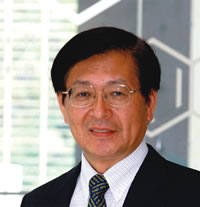|
|
Vol.
34 No. 1
January-February 2012
by Kazuyuki Tatsumi
 |
The International Year of Chemistry 2011 has been an immense success. This owes much to the initial strategy planning led by Peter Mahaffy, the efforts of the IYC Management Committee headed by John Malin, and the leadership of successive IUPAC Presidents Bryan Henry, Jung-Il Jin, and Nicole Moreau, along with Secretary General David Black and Treasurer John Corish. It goes without saying that the success is also due to many devoted and active IUPAC members, to name quite a few, who were involved with the planning and execution of events and activities. The Global Water Experiments and the IYC competitions such as “Chemistry Cartoons,” “A World without Polymers,” and “Global Stamps,” which were featured in Chemistry International (Nov-Dec 2011), are typical examples.
An important aspect of IYC2011 is that it has drawn the attention of chemists and young people worldwide. According to the IYC website, 170 countries/regions have participated in IYC activities, and over 8 800 individuals have registered on the IYC network. In addition to the three Cornerstone Events, around 1 400 activities have been listed on the IYC web; inclusion of IYC programs independently organized by the chemical societies of the world would more than double this number. It should be emphasized that more than 100 countries/regions, which do not have NAO or ANAO recognition by IUPAC, have taken part in these activities, and that some of them have established their own official IYC websites, which show vitality and enthusiasm. These include Andorra, Columbia, Costa Rica, Ecuador, Gabon, Guatemala, Haiti, Iceland, Latvia, Lebanon, Morocco, Oman, Paraguay, Peru, Syrian Arab Republic, and Venezuela. The participation of these non-NAO organizations is an encouraging sign for the future of IUPAC because it elevates the visibility of chemistry and the reputation of the Union. It also strengthens the link between IUPAC and chemical communities worldwide, as well as providing opportunities for increasing the Union’s membership.
Although IYC2011 came to an official end at the closing ceremony in Brussels in early December, IYC activities will still continue into 2012. And the enthusiasm of chemists about IYC2011 and the momentum of IUPAC as a world-leading organization should be maintained, and enhanced. Thus, the overarching theme for my presidential term will be “to pave the way to carry over the momentum created by IYC2011 to the next step.”
Based on my two previous columns as vice president (Nov-Dec 2010 and Jul-Aug 2011 CI), I presented my Vice President’s Critical Assessments at the IUPAC Council Meeting in San Juan, Puerto Rico. I feel we have four important missions, which need immediate action.
There is no question that the power of chemistry is a prerequisite for a sustainable solution to human health and environmental problems. Therefore, IUPAC should respond promptly and properly to these global interests and urgent necessities, and I am confident that IUPAC will be able to do it, with the cooperation of ICSU, UNESCO, and other UN agencies.
The importance of IUPAC activities ought to be recognized widely. In this regard, we should target three specific areas, namely the leading chemical circles, chemical communities in emerging countries, and the general public. In addition, I wish to develop even closer ties between IUPAC and the International Organization of the Chemistry Olympiads.
Both Chemistry as a scientific discipline and IUPAC as an international union are facing challenges. The key issue for us is to continue to make innovative changes to the IUPAC structure as well as its relationship with chemistry communities. Furthermore, we must aim at augmenting participation and increasing the number of National Adhering Organizations.
We must continue to address the current needs of the world community through the development of Chemistry. IUPAC will soon be looking forward to its Centennial Celebration in 2019. It is not too early to start planning now for the 100th anniversary of IUPAC, which will provide us with a very specific landmark and a wonderful opportunity to celebrate the role of IUPAC in the achievements of chemistry.
In conjunction with the above key issues, IUPAC should obtain NGO status from the United Nations as quickly as possible. We should also update the existing History of IUPAC from 1999 to the centenary year. And, let’s target the aforementioned aim of increasing membership and reaching 100 NAOs by our centennial in 2019.
During the IUPAC General Assembly held last year in San Juan, I visited division and committee meetings. It was quite encouraging for me to witness the enthusiasm of our expert members in planning and conducting various challenging projects. This is where the activities of IUPAC really come from. We have seen recent reforms to IUPAC structures, functions, and governance, which have improved operational efficiency. Now we must work to encourage the positive attitude, enthusiasm, and devotion of our members toward IUPAC activities. My intention as president is to continue to promote reforms while maintaining a positive and harmonious atmosphere in which we may take pride in working together for IUPAC.
I am very much looking forward to working with all the IUPAC members in the next biennium, targeting our centennial celebration in 2019. Any advice or ideas are very welcome, either from the IUPAC body or other groups.
Kazuyuki Tatsumi’s <[email protected]> term as president of IUPAC began on 1 January 2012. Previously, he served as vice president of IUPAC and vice president and president of the Inorganic Chemistry Division. Tatsumi is a professor at Nagoya University and is a member of the Science Council of Japan (NAO for Japan).
Page
last modified 6 January 2012.
Copyright © 2003-2012 International Union of Pure and Applied Chemistry.
Questions regarding the website, please contact [email protected] |